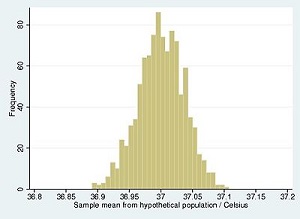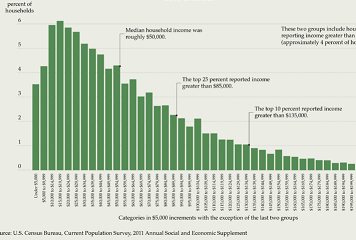Notes to a video lecture on http://www.unizor.com
Function Limit - Properties of Limits
Theorem 1
If f(x)→a as x→r, then for any positive A
A·f(x)→A·a as x→r.
Proof
(1a) Using a definition of function limit based on convergence of {f(xn)} to a for any {xn}→r, the proof is in the corresponding property of a sequence limit, since {A·f(xn)}converges to A·a.
Indeed, take any sequence of arguments {xn} that converges to r.
Since {f(xn)}→a,
{A·f(xn)}→A·a by known property of the converging sequences.
So, we have just proven that
∀ {xn}→r: {A·f(xn)}→A·a, which corresponds to the first definition of convergence of function A·f(x) to A·a.
(1b) Let's prove this using ε-δdefinition of a function limit.
It's given that
∀ ε>0 ∃ δ>0:
|x−r| ≤ δ ⇒ |f(x)−a| ≤ ε
We have to prove that
∀ ε>0 ∃ δ>0:
|x−r| ≤ δ ⇒ |A·f(x)−A·a| ≤ ε
Using the fact that f(x)→a in
Step 1 - choose any positive ε.
Step 2 - calculate ε' = ε/A.
Step 3 - using the convergence of f(x), for this ε' find δ such that, if x is within
Step 4 - we have proven that, as long as x is within
a−ε' ≤ f(x) ≤ a+ε';
since ε'=ε/A, represent it using original ε as
a−ε/A ≤ f(x) ≤ a+ε/A.
Step 5 - multiply all parts of this inequality by A (it's positive, so signs of inequality are preserved) getting
A·a−ε ≤ A·f(x) ≤ A·a+ε.
This means that A·f(x) is within
End of proof.
Theorem 2
If f(x)→a as x→r and
g(x)→b as x→r,
then
f(x)+g(x)→a+b as x→r.
Proof
(2a) Using a definition of function limit based on convergence of {f(xn)} to a and{g(xn)} to b for any {xn}→r, the proof is in the corresponding property of a sequence limits, since {f(xn)+g(xn)} converges to a+b.
(2b) Let's prove this using ε-δdefinition of a function limit.
Step 1 - choose any positive ε.
Step 2 - calculate ε' = ε/2.
Step 3 - using the convergence of f(x), for this ε' find δ1 such that, if x is within
Step 4 - using the convergence of g(x), for this ε' find δ2 such that, if x is within
Step 5 - calculate
δ = min(δ1, δ2);
for this δ both statements are true:
f(x) is within
g(x) is within
Step 6 - we have proven that, as long as x is within
a−ε' ≤ f(x) ≤ a+ε' and
b−ε' ≤ g(x) ≤ b+ε';
since ε'=ε/2, represent it using original ε as
a−ε/2 ≤ f(x) ≤ a+ε/2 and.
b−ε/2 ≤ g(x) ≤ b+ε/2;
Step 7 - add these inequalities getting
a+b−ε ≤ f(x)+g(x) ≤ a+b+ε.
This means that f(x)+g(x) is within
End of proof.
Theorem 3
If f(x)→a as x→r and
g(x)→b as x→r,
then
f(x)·g(x)→a·b as x→r.
Proof
(3a) Using a definition of function limit based on convergence of {f(xn)} to a and{g(xn)} to b for any {xn}→r, the proof is in the corresponding property of a sequence limits, since {f(xn)·g(xn)} converges toa·b.
(3b) Let's make some preparations before proving this theorem using ε-δ terminology.
We have to prove that
|f(x)·g(x)−a·b|→0 as x→r.
Recall a known inequality about absolute values:
|A+B| ≤ |A|+|B|.
We will use it in this proof.
Since both our functions have finite limits, their values are sufficiently close to their corresponding limits as long as an argument is sufficiently close to a limit point.
In particular, there is always such δ1 that
Therefore, for
Make an invariant transformation with our expression:
|f(x)·g(x)−a·b| =
= |f(x)·g(x)−a·g(x)+a·g(x)−a·b|
The new expression, using the inequality with absolute values mentioned above, is bounded from above as follows:
|f(x)·g(x)−a·g(x)+a·g(x)−a·b|≤
≤|f(x)·g(x)−a·g(x)| +
+ |a·g(x)−a·b| =
= |g(x)|·|f(x)−a|+|a|·|g(x)−b| ≤
≤ (|b|+1)·|f(x)−a|+|a|·|g(x)−b|
After these preparations we are ready to prove the theorem using ε-δ definition of a function limit.
Step 1 - choose any positive ε.
Step 2 - let ε1 = ε/[2(|b|+1)].
Step 3 - using the convergence of f(x), for this ε1 find δ4 such that, if x is within
Step 4 - let ε2 = ε/(2|a|).
Step 5 - using the convergence of g(x), for this ε2 find δ5 such that, if x is within
Step 6 - calculate
δ = min(δ1, δ2, δ3, δ4, δ5);
for this δ both statements are true:
f(x) is within
g(x) is within
Step 7 - we have proven that, as long as x is within
|f(x)−a| ≤ ε1 and
|g(x)−b| ≤ ε2;
since ε1=ε/(|b|+1) and ε2=ε/|a|,
represent this using original ε as
|f(x)−a| ≤ ε/(|b|+1) and
|g(x)−b| ≤ ε/|a|;
Step 7 - use the above inequalities in the transformed inequality that we have to prove:
|f(x)·g(x)−a·b| ≤
≤ (|b|+1)·ε/[2(|b|+1)] +
+ |a|·ε/(2|a|) = ε
This means that f(x)·g(x) is within
End of proof.
Theorem 4
If f(x)→a ≠ 0 as x→r
then
1/f(x)→1/a as x→r.
Proof
(4a) Using a definition of function limit based on convergence of {f(xn)} to a for any {xn}→r, the proof is in the corresponding property of a sequence limits, since {1/f(xn)}converges to 1/a.
(4b) Let's prove this using ε-δdefinition of a function limit.
It's given that
∀ ε>0 ∃ δ>0:
|x−r| ≤ δ ⇒ |f(x)−a| ≤ ε
We have to prove that, assuming a ≠ 0,
∀ ε>0 ∃ δ>0:
|x−r| ≤ δ ⇒ |1/f(x)−1/a| ≤ ε
First of all, since a ≠ 0, function values of f(x) are separated from 0 as long as argument x is sufficiently close to a limit point r.
Indeed, take ε = a/2 and find δ1such that f(x) is in
Notice now that
|1/f(x)−1/a|=|f(x)−a| / |f(x)|·|a|
Since a/2 ≤ f(x) ≤ 3a/2 in the
Therefore,
|1/f(x)−1/a| ≤ 2·|f(x)−a| / a²
Using the fact that f(x)→a in
Step 1 - choose any positive ε.
Step 2 - calculate ε' = ε·a²/2.
Step 3 - using the convergence of f(x), for this ε' find δ2 such that, if x is within
Step 4 - set δ = min(δ1, δ2).
Step 5 - we have proven that, as long as x is within
|f(x) − a| ≤ ε' = ε·a²/2.
Step 6 - substitute this into inequality above:
|1/f(x)−1/a| ≤ 2·|f(x)−a| / a² ≤
≤ 2·(ε·a²/2) / a² = ε.
This means that 1/f(x) is within
End of proof.



